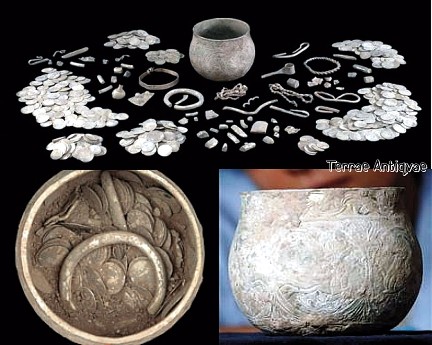Encuentran un tesoro vikingo con un detector de metales
Un padre y su hijo hallaron con un detector de metales el tesoro vikingo de mayor relevancia encontrado en el Reino Unido en más de 150 años, informaron hoy las autoridades locales.
David y Andrew Whelan se toparon el pasado enero con un botín vikingo en buenas condiciones que incluía, entre otros objetos de valor, 617 monedas de plata, un brazalete de oro y una jarra labrada en plata, fabricada en Francia en la primera mitad del siglo IX, cuando rastreaban un área de la localidad norteña de Harrogate.
El Museo Británico, donde esas piezas fueron examinadas por especialistas, señaló que el tesoro tiene "relevancia mundial". Los objetos encontrados, que datan del siglo IX, proceden de lugares tan variopintos como Afganistán, Irlanda, Rusia, Escandinavia y la Europa continental, según los expertos del museo. La mayor parte de las piezas estaban en el interior de la jarra plateada, considerada el hallazgo más espectacular, que podría haberse utilizado en servicios religiosos y que probablemente los vikingos robaron de un monasterio o les fue entregada como tributo.
Entre las monedas se aprecian algunos ejemplares únicos, que aportan información nueva y valiosa sobre la historia de Inglaterra a comienzos del siglo X, así como del condado norteño de Yorkshire. Otras de esas monedas guardan relación con el islam, el cristianismo y religiones anteriores. Además, un tribunal de Harrogate declaraba hoy el hallazgo "tesoro nacional".
El juez de instrucción de North Yorkshire Geoff Fell comentó que el caso de los objetos encontrados por los Whelan era uno de los "más increíbles" y señaló que en este condado inglés se sentían "muy orgullosos" de su herencia vikinga. Por otro lado, en una conferencia de prensa hoy en el Museo Británico, el comisario Jonathan Williams subrayó la "importancia histórica" de las piezas halladas, de las que indicó que "cuentan una historia diferente de ese periodo".
Fuente: EFE, Reino Unido / ABC.es, 19 de julio de 2007
Enlace: http://www.abc.es/20070719/internacional-europa/
encuentran-tesoro-vikingo-detector_200707192046.html
Web recomendada: Sweden's Museum of National Antiquities
(2) Viking treasure unearthed on English farm
Father and son find riches that were plundered a millennium ago
A 9th-century gilt silver vessel, discovered by a father-son team of treasure hunters, sits in the middle of this display of a Viking hoard. More than 600 coins and 65 other items were found in and around the vessel.
By Raphael G. Satter, July 19, 2007
LONDON - One of the biggest Viking treasures ever found has been discovered on an English farm by a father-son team of treasure hunters, the British Museum announced Thursday.
The trove of coins and jewelry was buried more than 1,000 years ago a collection of items from Ireland, France, Russia and Scandinavia that testified to the raiders international reach.
Its a fascinating find, its the largest find of its type of over 150 years, said Gareth Williams, an expert at the British Museum who examined the items.
He said it was the largest such find in Britain since the 1840 discovery of the Cuerdale Hoard a mass of 8,500 silver coins, chains, and amulets.
David Whelan, 60, and his 35-year-old son Andrew were trawling a through a farmers field near Harrogate, in northern England, on Jan. 6 when their metal detector squealed. The pair began digging, finding a silver bowl more than a foot beneath the soil. Under British law, such finds must be reported to authorities.
The pair turned the bowl over to archaeological experts, who discovered it was packed with coins and jewelry. The bowl, a 9th-century gilt silver container probably seized by Vikings from a monastery, had been used as an improvised treasure chest before being buried.
A gilt silver vessel dating back to the 9th century is shown at the British Museum on Thursday.
We thought it was marvelous, David Whelan told The Associated Press. But we didnt know for nearly a month what was in it.
In all, more than 600 coins and dozens of other objects, including a gold arm band, silver ingots and fragments of silver were found in and around the container.
Some of the coins mixed Christian and pagan imagery, shedding light on the beliefs of newly Christianized Vikings, said Gareth Williams, a curator of early medieval coins at the British Museum.
The booty was likely accumulated through a combination of commerce and warfare, Williams said. Its quantity indicated that at least some of it was taken by force, perhaps in raids on northern Europe or Scandinavia, he added.
The items were manufactured as far afield as Afghanistan, Russia and Scandinavia.
The Vikings raids were chronicled as early as the 8th century by Christian monks on the coasts of northern Europe. The raids spread throughout Europe, from modern day Spain to Turkey.
In some places, the raids grew into full-fledged invasions, and Viking kingdoms were established in Britain, Ireland, and Normandy, France, among other places.
The British Museum said the loot was hidden sometime after the fall of the Viking Kingdom of Northumbria in 927. Vikings often buried their wealth in times of trouble.
The museum said it hoped to buy at least some of the hoard from the Whelan family once its value was determined.
Whelan, for his part, said he and his son enjoyed their walks through the countryside and would keep hunting together on the weekends.
If we hadnt found it we wouldve still been going, he said. We just keep going, we enjoy it.
© 2007 The Associated Press.
Source: http://www.msnbc.msn.com/id/19861099/
Canal de Vídeos: Vikingos

1 comentario
Giancarlo -